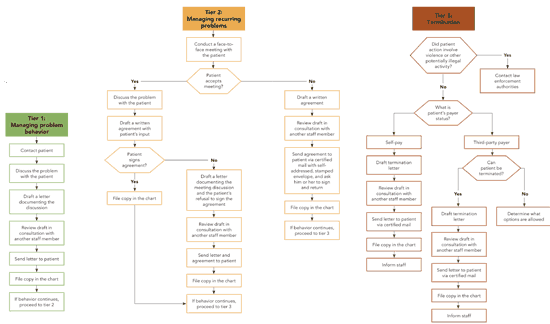
A standardized approach will help you determine whether your relationship is broken and what to do about it.
Fam Pract Manag. 2005;12(8):34-38

Many family physicians chose the specialty of family medicine because of the value placed on the therapeutic relationship between the patient and the physician. When that relationship is significantly or repeatedly challenged, family physicians feel it deeply, and it’s not always clear how best to address the problem.
We have found that, when emotions are high, having a standardized process for dealing with these challenges makes it easier to take appropriate action. Our process provides patients with plenty of opportunities to reconsider their behavior and re-engage in the relationship, when appropriate, and it provides the physician and staff the assurance that comes with following a reasoned, consistent approach when difficult circumstances arise. If it becomes necessary to terminate the relationship, our approach describes how to do it without running afoul of payers’ guidelines.
While our system is not perfect, it has significantly improved our ability to set expectations and draw boundaries in an environment where some payers have very narrowly defined the circumstances under which termination is acceptable. The flow charts in this article are based on ones we have used with success in our health system. You can download them below and adapt them for use in your practice.
Working it out
An appropriate response depends on the type of events that have strained the relationship, and these can vary widely, from behaviors that annoy you, such as multiple missed appointments, to those that make you angry, such as unpaid bills, to those that cause you or your staff to feel threatened. The least severe incidents can usually be addressed by discussing them with the patient or through a discussion between the patient and the office manager or administrator. The most severe incidents may call for immediate termination. In our group, the medical director reviews significant incidents and has the authority to adapt the response if the situation or the rules of the patient’s insurer call for it.
The first step to take when evaluating a potentially broken relationship with a patient may be a step backwards. Unless the patient’s misconduct is severe, it is often productive to step back and consider whether you have done everything you reasonably can to salvage the relationship. Investing this extra effort has transformed some of our most challenging relationships into ones where the patients are engaged and invested partners in their health care and appreciative of the work of our staff and physicians.
Patients sometimes escalate their behavior when they feel they aren’t getting the services they expect or when they feel their needs aren’t being addressed. Taking time to sit down with the patient with the goal of better understanding the underlying expectations or needs that are driving his or her behavior can be valuable. Some patients have unreasonable expectations, but for others, understanding the point they’re trying to make can go a long way in repairing the relationship. Patients may be frustrated by the way we deliver care in our office or by other parts of the health care system (other providers, other hospitals or third-party payers). Learning about the root cause of their dissatisfaction can help us improve the delivery of care to all our patients.
Of course angry patients can make offensive remarks about you and your staff. The quickest response is often a defensive one. Since listening is very difficult to do when you are being accosted, deferring the patient to another member of your staff who is less invested in the relationship or the process of care can be quite helpful. You can do this with a simple statement such as, “I understand you are upset. To make sure we address your concerns to the best of our ability, let me get the office manager to assist you.” Distancing yourself from the situation in this way can keep you from saying things you’ll wish you hadn’t and might provide you with valuable perspective.
If you don’t have this opportunity, or if your office staff have exhausted their efforts to communicate with the patient, you may be able to refer the patient to another resource. Most health plans have member service representatives to which you can refer a challenging patient.
Patient adherence, or lack thereof, can be as big a problem as disruptive behavior in the office. If a patient isn’t complying with your treatment recommendations, be sure to document that fact in the patient’s record, as well as your efforts to inform the patient about the potential consequences of noncompliance – both in terms of his or her health and your ability to continue as his or her physician.
Sometimes, no matter what you do, there is no hope of resurrecting the relationship. In this case, your chances of successfully ending the relationship are greatest if you have communicated clearly with the patient about the process, what to expect and the consequences of continued problems. Direct statements such as, “If you do this again, we will no longer care for you, and you will have to go to another practice,” can be quite eye-opening for some patients. Ultimately, if you’ve followed an approach like the one depicted on the following pages, the patient should not be surprised when you terminate the relationship.
MANAGING DIFFICULT PHYSICIAN-PATIENT RELATIONSHIPS
The flowcharts below depict a three-tiered approach similar to the process used in our health system. For this approach to be effective, you must categorize the types of problems you encounter in your practice into three tiers. For example, in our system, tier 1 behaviors include a patient missing five appointments in six months or a patient using abusive language while talking with a staff member. Tier 2 behaviors include a continuation of issues identified in tier 1, or any actions that staff perceived as threatening. Tier 3 behaviors include a continuation of issues identified in tier 2, or any violent or potentially illegal actions.

Calling it quits
The typical termination procedure involves consulting with the patient’s insurer about your plans, then sending a letter to the patient by certifed mail, with a return receipt requested. The letter should explain that the relationship has been terminated and that you will continue to direct the patient’s care for emergent issues until a specific date approximately 30 days from the notification letter (see the sample letter). Don’t forget to keep your office staff, and particularly your scheduler, in the loop.
Unless otherwise specified by the patient’s health plan, the primary care physician generally doesn’t have further obligations to assist the patient in finding another physician. Assisting the patient in transferring medical records to another physician is important, however. It signals your interest in facilitating continuity of care. Because of privacy requirements, you should not contact the patient’s future physician about the dissolution (no matter how tempting it may be) unless that provider is a business associate of yours.
In some instances, the patient may not pick up the certified letter. In that situation, if he or she contacts you after 30 days and tries to schedule another appointment or even shows up at your clinic, you must show him or her a copy of the letter and pleasantly but firmly reiterate that you will no longer care for the patient because of his or her behavior.
SAMPLE TERMINATION LETTER
When you decide to end your relationship with a patient, inform him or her in writing and send the letter by certified mail, with a return receipt requested. If it’s possible to describe the reason for the termination in a brief, clear, objective way, do so in the letter. If not, you might be better off not providing a reason. The patient ought to be aware of the reason as a result of earlier discussions and correspondence. Some malpractice insurance carriers offer sample termination letters, or you can adapt the following sample.
Dear [patient name],
As you know, a good relationship between a physician and his or her patient is essential for quality medical care. There are times when this relationship is no longer effective and the physician finds it necessary to ask the patient to select another physician.
This letter is to inform you that I am no longer willing to be your primary care physician. The reason for this decision is [describe reason briefly, or omit this sentence]. Our office will continue to direct your care for any emergencies that arise over the next 30 days. It is imperative that you select another physician and arrange with our office for your records to be sent to your new physician before [date]. Your insurance plan or the local medical society [insert contact information] will be able to assist you in choosing a new physician.
Sincerely,
[Physician’s name]
Third parties
Third-party payers typically have their own policies and procedures about terminating a patient-physician relationship. These may affect your response. Obtaining copies of the policies in at the first sign of trouble can be useful. In our state, most of the commercial policies require notification of the insurance company and then a 30-day notice to the patient.
Government payers, however, have stricter policies. Involuntary disenrollment of a patient in a government health coverage plan can be strictly regulated by the state. High-level governmental review and approval of the documentation surrounding the dissolution of the patient-physician relationship may be required before the patient can be involuntarily disenrolled. When you have a relationship with a Medicare or Medicaid enrollee that you think needs to be terminated, carefully review your provider manual and state regulations. Our state generally requires demonstration of significant wrap-around services (such as anger management counseling or social worker intervention) or transfer to another provider within our system (a “second chance”) before the patient can be transferred to another system or involuntarily disenrolled.
RISK MANAGEMENT
Physicians’ offices are subject to state and federal civil rights laws. The AMA says a physician may not decline to accept patients because of “sex, color, creed, race, religion, disability, ethnic origin, national origin, sexual orientation, age or any other basis that would constitute invidious discrimination.” Lawsuits that allege discrimination or violations of the Americans With Disabilities Act are increasing. If you are considering ending your relationship with a patient who is in a protected class or disabled, you may want to consult an attorney to assess your liability risk.
Having a plan helps
Terminating a patient-physician relationship is never fun. But in our experience, the termination process is much easier if we follow a standardized approach for all of our challenging relationships.